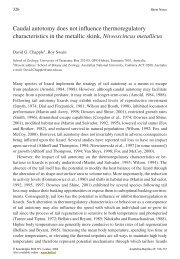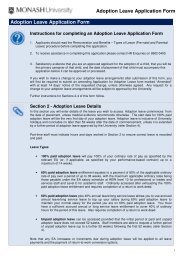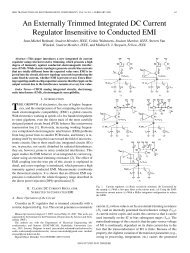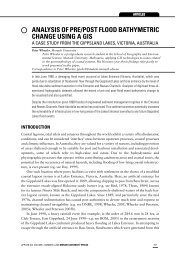Strain-rate development between a co-rotating Lamb-Oseen vortex ...
Strain-rate development between a co-rotating Lamb-Oseen vortex ...
Strain-rate development between a co-rotating Lamb-Oseen vortex ...
Create successful ePaper yourself
Turn your PDF publications into a flip-book with our unique Google optimized e-Paper software.
16 th Australasian Fluid Mechanics Conference<br />
Crown Plaza, Gold Coast, Australia<br />
2-7 December 2007<br />
<strong>Strain</strong>-<strong>rate</strong> <strong>development</strong> <strong>between</strong> a <strong>co</strong>-<strong>rotating</strong> <strong>Lamb</strong>-<strong>Oseen</strong> <strong>vortex</strong> pair of unequal<br />
strength.<br />
Hannah Busch 1 , Kris Ryan 1 & Gregory J. Sheard 1,2<br />
1 Fluids Laboratory for Aeronautical and Industrial Research (FLAIR), Department of Mechanical Engineering<br />
Monash University, VIC, 3800, Australia.<br />
Abstract<br />
2 Monash University Biomedical Engineering Technology Alliance (MuBeta)<br />
Monash University, VIC 3800, Australia<br />
To date, several investigations have <strong>co</strong>nsidered the prospect of<br />
enhanced dissipation of a <strong>vortex</strong> pair due to elliptic (short wave)<br />
instabilities. Recent studies indicate that these modes have the<br />
potential to significantly reduce the time taken to dissipate <strong>vortex</strong><br />
pairs. This has gene<strong>rate</strong>d interest in the aviation industry, where<br />
aircraft trailing wakes pose a significant hazard for nearby<br />
aircraft.<br />
Of note, recent studies have indicated that the growth <strong>rate</strong> of<br />
these short-wave instability modes depends strongly on the<br />
strain-<strong>rate</strong> developed within the <strong>co</strong>re of each <strong>vortex</strong>. This strain<strong>rate</strong><br />
has been shown to develop naturally simply due to the<br />
presence of both vortices.<br />
Studies to date have <strong>co</strong>ncent<strong>rate</strong>d on <strong>vortex</strong> pairs where each<br />
<strong>vortex</strong> has the same magnitude of circulation. We extend this by<br />
varying the circulation ratio of the two vortices; the circulation of<br />
one <strong>vortex</strong> is varied while the circulation of the other remains<br />
<strong>co</strong>nstant. The effect on the strain-<strong>rate</strong> which develops within<br />
each <strong>co</strong>re is <strong>co</strong>nsidered. Of particular interest are the time-scales<br />
involved in both the strain-<strong>rate</strong> <strong>development</strong> and in the twodimensional<br />
merging process, as sufficient time is required for<br />
short-wavelength instabilities to occur prior to merging for the<br />
process to successfully reduce dissipation time.<br />
A spectral-element method is used to <strong>co</strong>nduct the DNS<br />
investigation at a circulation Reynolds number of Re Γ = 20,000.<br />
Introduction<br />
A significant problem facing the aviation industry today is the<br />
danger imposed by large <strong>co</strong>mmercial aircraft trailing wakes. The<br />
wake region of an aircraft is highly turbulent and <strong>co</strong>ntains a<br />
<strong>co</strong>unter <strong>rotating</strong> <strong>vortex</strong> pair that remains <strong>co</strong>herent for a long time<br />
(Gerz, Holzäpfel & Darracq 2002). This poses a significant<br />
hazard to trailing aircraft; a loss of <strong>co</strong>ntrol may occur when<br />
entering a wake of another aircraft and a number of accidents and<br />
near misses have been re<strong>co</strong>rded (FAA Wake Turbulence Training<br />
Aid, 2007).<br />
Co-<strong>rotating</strong> vortices develop with circulation of the same sign; an<br />
example of this is a wing-tip / wing-flap pair. As they travel<br />
downstream of generation, they interact and a merging process<br />
takes place. This merger results in a single <strong>vortex</strong> that, due to<br />
symmetry about the centreline of an aircraft, be<strong>co</strong>mes one half of<br />
a <strong>co</strong>unter-<strong>rotating</strong> <strong>vortex</strong> pair of a trailing wake.<br />
Figure 1 illust<strong>rate</strong>s the parameters of a <strong>co</strong>-<strong>rotating</strong> <strong>vortex</strong> pair<br />
that will be discussed throughout this paper. The effective <strong>vortex</strong><br />
radius is defined as a, the separation <strong>between</strong> the <strong>co</strong>res as b, and<br />
the circulations as Γ 1 and Γ 2 respectively.<br />
Figure 1 : 2D representation of <strong>co</strong>-<strong>rotating</strong> parallel vortices. Here a is the<br />
characteristic <strong>vortex</strong> radius, b is the separation distance <strong>between</strong> the<br />
<strong>vortex</strong> <strong>co</strong>res and the <strong>vortex</strong> circulations as Γ 1 and Γ 2 respectively.<br />
One of the key parameters in this field of research is the<br />
Reynolds number based on the circulation of a <strong>vortex</strong>. This is<br />
defined as the ratio <strong>between</strong> circulation and the vis<strong>co</strong>us forces:<br />
where<br />
is the kinematic vis<strong>co</strong>sity of the fluid.<br />
A number of parameters have been studied extensively regarding<br />
the merging process including circulation Reynolds number,<br />
<strong>vortex</strong> strength, separation <strong>between</strong> the <strong>co</strong>res of the vortices and<br />
<strong>vortex</strong> radius. It has been determined experimentally by Meunier<br />
& Leweke (2001) that for equal-circulation equal-strength <strong>co</strong><strong>rotating</strong><br />
vortices, a critical value of separation ratio exits as<br />
a<br />
0.29 0.01. Below this value merging will not occur<br />
b<br />
c<br />
under the inviscid <strong>co</strong>nditions. When vis<strong>co</strong>us effects are taken into<br />
ac<strong>co</strong>unt, a diffusive stage exists where the <strong>vortex</strong> radii grow until<br />
a a<br />
which marks the start of the merging process<br />
b b<br />
c<br />
(Meunier & Leweke 2001). The radial growth <strong>rate</strong> has been<br />
shown to occur ac<strong>co</strong>rding to<br />
(2)<br />
where a 0 is the initial <strong>vortex</strong> radius, is the fluid vis<strong>co</strong>sity and t<br />
is the current time.<br />
A key feature of interacting vortices is the growth of threedimensional<br />
instabilities. Crow (1970) first described a longwave<br />
instability mode growing within the trailing vortices of<br />
aircraft. It develops sinusoidally within <strong>co</strong>unter-<strong>rotating</strong> <strong>vortex</strong><br />
pairs, forming <strong>vortex</strong> rings which rapidly dissipate. The Crow<br />
instability has a relatively slow growth <strong>rate</strong> enabling vortices to<br />
remain <strong>co</strong>herent for extended periods.<br />
(1)<br />
1470
Jimenez (1975) analytically determined that <strong>co</strong>-<strong>rotating</strong> <strong>vortex</strong><br />
pairs would be stable to this Crow instability and Meunier &<br />
Leweke (2005) <strong>co</strong>nfirmed this, noting that there was no longwave<br />
instability observed when they experimentally studied a <strong>co</strong><strong>rotating</strong><br />
<strong>vortex</strong> pair. In an experimental study by Leweke &<br />
Williamson (1998) on <strong>co</strong>unter-<strong>rotating</strong> vortices, a shorter<br />
wavelength instability was observed to occur <strong>co</strong>ncurrently with<br />
the Crow instability. They found it to significantly increase the<br />
normalized instability growth <strong>rate</strong> σ*, and identified this shortwave<br />
instability to be an elliptical instability, in which the <strong>vortex</strong><br />
<strong>co</strong>re streamlines are elliptically deformed. Meunier & Leweke<br />
(2005) found that, for a <strong>co</strong>-<strong>rotating</strong> <strong>Lamb</strong>-<strong>Oseen</strong> <strong>vortex</strong> pair, the<br />
presence of elliptical instabilities resulted in an earlier onset of<br />
the merging process than <strong>co</strong>rresponding two-dimensional models<br />
for Re Γ > 2000. It was proposed that these instabilities lead to a<br />
quick growth of hence aiding the merging process.<br />
In Kerswell‟s (2002) review of elliptical instability he remarks<br />
that the growth <strong>rate</strong> of three-dimensional elliptical instabilities<br />
scale with strain-<strong>rate</strong>. A number of other studies state that the<br />
elliptical deformations, which lead to elliptical instabilities,<br />
develop as a result of mutually induced strain (Le Dizès &<br />
Laporte 2002, Leweke & Williamson 1998). Le Dizès & Verga<br />
(2002) found two-dimensional <strong>co</strong>-<strong>rotating</strong> vortices elliptically<br />
deform identically on a non-vis<strong>co</strong>us time scale for 500≤ Re Γ ≤<br />
16,000, demonstrating a link <strong>between</strong> the flow Reynolds number<br />
and the underlying strain field.<br />
However, to date there has not been any emphasis placed on how<br />
the strain-<strong>rate</strong> develops within a <strong>Lamb</strong>-<strong>Oseen</strong> <strong>vortex</strong> pair when<br />
<strong>co</strong>nsidering a <strong>vortex</strong> pair of unequal circulation (i.e. for = 1/ 2<br />
1). The simulations reported here demonst<strong>rate</strong> the relationship<br />
<strong>between</strong> the ratio of circulations and the <strong>vortex</strong> <strong>co</strong>re strain-<strong>rate</strong><br />
for unequal <strong>co</strong>-<strong>rotating</strong> vortices.<br />
Flow Geometry<br />
When analysing <strong>vortex</strong> pair interactions, prior studies have<br />
<strong>co</strong>nsidered a number of different <strong>vortex</strong> profiles. In particular,<br />
researchers have <strong>co</strong>nsidered Batchelor, <strong>Lamb</strong>-<strong>Oseen</strong> and Rankine<br />
profiles. The simplest of these is the Rankine profile, <strong>co</strong>nsisting<br />
of uniform vorticity out to the maximum <strong>vortex</strong> radius (Treiling,<br />
Fuentes & van Heijst 2005).<br />
Meunier & Leweke (2001) found experimentally that an initial<br />
<strong>vortex</strong> profile was of Gaussian type, and Le Dizès & Verga<br />
(2002) numerically demonst<strong>rate</strong>d that any two dimensional<br />
axisymmetric <strong>vortex</strong> will relax towards a Gaussian profile. A<br />
Gaussian profile has a peak vorticity at the <strong>co</strong>re which<br />
exponentially decreases outwards. A Gaussian type <strong>vortex</strong> profile<br />
is represented by,<br />
(3)<br />
where r is the radial distance from the centre and a o is the initial<br />
<strong>vortex</strong> radius. This particular profile is known as the <strong>Lamb</strong>-<br />
<strong>Oseen</strong> <strong>vortex</strong> (Le Dizès & Verga 2002).<br />
Our study <strong>co</strong>nsiders a <strong>Lamb</strong>-<strong>Oseen</strong> <strong>vortex</strong> pair, and initially both<br />
vortices have the profile described by equation 3. However,<br />
unlike prior studies, we <strong>co</strong>nsider the case where each <strong>vortex</strong><br />
within the pair has a different circulation. In order to do this, we<br />
define the circulation ratio as<br />
(4)<br />
where 2 is the circulation of the dominant <strong>vortex</strong>, and 1 is the<br />
circulation of the weaker <strong>vortex</strong>. To the authors‟ knowledge,<br />
prior studies have only <strong>co</strong>nsidered | | = 1.<br />
In order to <strong>co</strong>mpare results with prior investigations, a nonvis<strong>co</strong>us<br />
time scale is being used, defined as<br />
(5)<br />
Here, Γ is the circulation of the dominant <strong>vortex</strong> and a 0 is the<br />
initial radius of the dominant <strong>vortex</strong>.<br />
To ensure that the results obtained are meaningful, a <strong>co</strong>mparison<br />
with the findings of Le Dizès & Verga (2002) was made. In their<br />
studies they investigated equal strength <strong>co</strong>-<strong>rotating</strong> <strong>vortex</strong> pairs<br />
for vortices with a variety of profiles. They noted that the<br />
addition of two identical Gaussian vortices was not a solution of<br />
the Navier-Stokes equations. A „relaxation‟ period was described<br />
during which the vortices adjust to form an elliptic profile. After<br />
this adjustment period (which was found to be inviscid) the two<br />
vortices diffuse, gradually increasing their aspect ratio prior to<br />
merging. They found that the Gaussian profile was a global<br />
attractor of any two-dimensional axisymmetric <strong>vortex</strong>; the more<br />
Gaussian-like the initial profile, the quicker the relaxation period.<br />
The variable used by Le Dizès & Verga (2002) to describe the<br />
temporal change in <strong>vortex</strong> profile over the relaxation period was<br />
the eccentricity of the <strong>vortex</strong> profile, ε. They noted that the<br />
eccentricity was a function of the strain field which one <strong>vortex</strong><br />
imposed on the other, defining the eccentricity as<br />
(6)<br />
Here, S i is the internal strain-<strong>rate</strong> (defined as the strain measured<br />
at the <strong>vortex</strong> <strong>co</strong>re imposed from both vortices) and ω z is the<br />
vorticity measured at the <strong>co</strong>re. Although Le Dizès & Verga<br />
(2002) investigated flow Reynolds numbers <strong>between</strong> 500 ≤ Re Γ ≤<br />
16000, they found only a weak dependence on Reynolds number.<br />
Numerical Technique<br />
The direct numerical simulations of the governing fluid equations<br />
were <strong>co</strong>mpleted using a spectral-element method. The technique<br />
is 3 rd order accu<strong>rate</strong> in time and has been successfully used in<br />
several prior studies (e.g. Sheard et al 2007).<br />
For this study the circulation Reynolds number of the dominant<br />
<strong>vortex</strong> is being limited to Re Γ = 20,000 for two reasons. The first<br />
being that at low Reynolds numbers, vis<strong>co</strong>us effects be<strong>co</strong>me<br />
significant and cannot be neglected. A previous study by Le<br />
Dizès and Verga (2002) showed that within the Reynolds<br />
numbers 800≤ Re Γ ≤ 8000, merging of <strong>co</strong>-<strong>rotating</strong> vortices will<br />
always occur due to the vis<strong>co</strong>us diffusion of vorticity. The value<br />
chosen for this study is sufficiently high to minimise this vis<strong>co</strong>us<br />
diffusion. It also is sufficiently low that a turbulent flow regime<br />
will not develop. Spectral-element methods are best suited to<br />
smooth solutions (Karniadakis & Sherwin 2005), so turbulence is<br />
an undesirable flow regime. Turbulence modelling is also<br />
<strong>co</strong>mputationally expensive; to capture the fine flow structures, a<br />
very refined mesh is required which increases <strong>co</strong>mputational time<br />
beyond what is suitable for a study of this scale.<br />
At this Reynolds number, the circulation ratio has been varied<br />
<strong>between</strong> 0.1 ≤ Λ ≤ 1.0 in increments of 0.1. The initial separation<br />
ratio has been set at<br />
to delay the merging process,<br />
allowing for an extended period in which the <strong>vortex</strong> <strong>co</strong>re strain<strong>rate</strong><br />
can be observed.<br />
1471
S<br />
S<br />
Y<br />
Y<br />
Y<br />
Y<br />
Y<br />
Y<br />
Y<br />
Y<br />
Results<br />
Here, we <strong>co</strong>nsider the strain-<strong>rate</strong> <strong>development</strong> for both vortices<br />
as a function of reduced time, t*. The results are subdivided to<br />
<strong>co</strong>nsider the dominant <strong>vortex</strong> and the weaker <strong>vortex</strong> sepa<strong>rate</strong>ly.<br />
Dominant <strong>vortex</strong> results<br />
Figure 2 shows the time evolution of the strain-<strong>rate</strong> S for the<br />
dominant <strong>vortex</strong> at various values of Λ. Here the strain-<strong>rate</strong> has<br />
been calculated within the <strong>co</strong>re of the <strong>vortex</strong>, and includes the<br />
effects of both the internal and external strain fields.<br />
(a)<br />
2<br />
0<br />
-2<br />
2 4 6<br />
X<br />
(b)<br />
2<br />
0<br />
-2<br />
2 4 6<br />
X<br />
0.2<br />
(c)<br />
2<br />
(d)<br />
2<br />
0.15<br />
0<br />
0<br />
-2<br />
-2<br />
0.1<br />
2 4 6<br />
X<br />
2 4 6<br />
X<br />
(e)<br />
2<br />
(f)<br />
2<br />
0.05<br />
0<br />
0<br />
0<br />
0 40 80<br />
Figure 2 : Time evolution of the <strong>co</strong>re strain-<strong>rate</strong> S for the dominant <strong>vortex</strong><br />
for different ratios of circulation. Shown are = 0.3 (squares), = 0.6<br />
(triangles) and = 0.9 (circles). The relaxation period ends at t* 40 for<br />
all <strong>co</strong>nsidered.<br />
For each value of Λ, an initial increase in S is observed, prior to a<br />
sudden decrease in value. An oscillation in S over time is noted,<br />
until a steady-state <strong>co</strong>ndition is reached. The steady-state value of<br />
S is reached after approximately 40 normalized time units<br />
regardless of circulation ratio. However small oscillations are<br />
observed around a median value at later times.<br />
This weak fluctuation can be seen throughout vorticity profiles as<br />
well. Figure 3 pictorially shows the effect of the relaxation<br />
period. The periodic change in direction of eccentricity is due to<br />
the weaker <strong>vortex</strong> encircling the dominant one. At the<br />
<strong>co</strong>mmencement of the simulation (Figure 3a) the weaker <strong>vortex</strong><br />
is to the left of the dominant <strong>vortex</strong>. At the <strong>co</strong>nclusion of the<br />
simulation, the weaker <strong>vortex</strong> is to the right of the dominant<br />
<strong>vortex</strong> (Figure 3h). The position of the weaker <strong>vortex</strong> is made<br />
apparent in figure 3 by following the major axis direction of the<br />
dominant <strong>vortex</strong>.<br />
Referring back to Figure 2, the value of strain-<strong>rate</strong> is clearly<br />
affected by the value of ; this is not surprising, as | | 0, the<br />
weaker <strong>vortex</strong> has less influence on the dominant <strong>vortex</strong> and the<br />
strain-<strong>rate</strong> within the dominant <strong>vortex</strong> S 0. Our results <strong>co</strong>nfirm<br />
this <strong>co</strong>nclusion.<br />
Analysing the data outside the inviscid relaxation period (i.e. for<br />
t* > 40) we note that the strain-<strong>rate</strong> of the dominant <strong>vortex</strong><br />
gradually increases over time. This is due to vis<strong>co</strong>us diffusion<br />
which acts to increase the major axis of the <strong>vortex</strong> faster than the<br />
minor axis. Using a linear least squares fit, the increase in strain<strong>rate</strong><br />
may be modelled. Two important pieces of information <strong>co</strong>me<br />
from this model. First, we may extrapolate back to t* = 0, to find<br />
an „initial‟ strain-<strong>rate</strong>. This strain-<strong>rate</strong> is not observed<br />
numerically, however it allows us to <strong>co</strong>mpare the variation in S<br />
magnitude as a function of . Se<strong>co</strong>nd, the gradient of the line<br />
provides a measure of strain-<strong>rate</strong> growth, which is also observed<br />
to alter as a function of .<br />
t*<br />
(g)<br />
-2<br />
2<br />
0<br />
-2<br />
2 4 6<br />
X<br />
-2<br />
2 4 6<br />
X<br />
2 4 6<br />
2 4 6<br />
X<br />
X<br />
Figure 3 : Contours of vorticity throughout the relaxation period of the<br />
dominant <strong>vortex</strong> in the case Λ = 0.9. (a) represents the initial <strong>vortex</strong><br />
profile, (b) – (h) represent 10 ≤ t* ≤ 70 in increments of t* = 10. Of<br />
particular interest is the vorticity <strong>co</strong>ntours of (a)-(d) which are within the<br />
relaxation period.<br />
0.15<br />
0.1<br />
0.05<br />
(h)<br />
0<br />
0 0.2 0.4 0.6 0.8 1<br />
Figure 4 : Estimated strain-<strong>rate</strong> at t* = 0 at the <strong>vortex</strong> <strong>co</strong>re. Dominant<br />
<strong>vortex</strong> (squares), se<strong>co</strong>ndary <strong>vortex</strong> (triangles). The increasing S i of the<br />
dominant <strong>vortex</strong> is indicative of the increasing strength of the se<strong>co</strong>ndary<br />
<strong>vortex</strong>. The decreasing S i of the se<strong>co</strong>ndary <strong>vortex</strong> is indicative of the<br />
decrease in relative strength of the dominant <strong>vortex</strong>.<br />
2<br />
0<br />
-2<br />
1472
<strong>Strain</strong> gradient<br />
S<br />
S<br />
Figure 4 shows the calculated, „initial‟ strain-<strong>rate</strong> of the dominant<br />
and weaker vortices as a function of . From the figure, it is seen<br />
that the „initial‟ <strong>co</strong>re strain-<strong>rate</strong> of the dominant <strong>vortex</strong> has a<br />
linear dependence on the strength of the weaker <strong>vortex</strong>. As<br />
1, the strain-<strong>rate</strong> in the stronger <strong>vortex</strong> be<strong>co</strong>mes more<br />
pronounced. This is expected; as increases, the weaker <strong>vortex</strong><br />
has a more dominating effect on the flow field, causing a stronger<br />
response from the dominant <strong>vortex</strong>.<br />
The gradient determined from the data shown in Figure 2 has a<br />
different trend to that of the initial values throughout the various<br />
values of Λ. Figure 5 shows these gradients as a function of Λ.<br />
0.00025<br />
0.0002<br />
0.00015<br />
0.0001<br />
5E-05<br />
0<br />
-5E-05<br />
0 0.2 0.4 0.6 0.8 1<br />
Figure 5 : Estimated strain-<strong>rate</strong> gradient at the <strong>vortex</strong> <strong>co</strong>re ac<strong>co</strong>rding to<br />
the non-vis<strong>co</strong>us time evolution of strain-<strong>rate</strong>. For <strong>co</strong>mparison is the<br />
dominant <strong>vortex</strong> (squares) and the se<strong>co</strong>ndary <strong>vortex</strong> (triangles).<br />
For circulation ratios of Λ = 0.5 or above, it can be seen that until<br />
t*=100, the strain-<strong>rate</strong> progressively increases at the <strong>co</strong>re of the<br />
dominant <strong>vortex</strong>. For values below Λ = 0.5, it appears that the<br />
<strong>co</strong>re strain-<strong>rate</strong> decreases with time.<br />
For Λ = 0.1, it can be deduced that the initial strain-<strong>rate</strong> is not<br />
large enough to produce a prolonged strain-<strong>rate</strong> decrease, hence<br />
the gradient is quite low. For Λ = 0.2 there is a rapid loss of<br />
vorticity experienced by the weaker <strong>vortex</strong> and the induced strain<br />
of approximately S = 0.02 is not maintained for a long time. As<br />
the weaker <strong>vortex</strong> dissapates to below ω = 0.1 there is a rapid<br />
decrease in the dominant <strong>vortex</strong> strain-<strong>rate</strong> as the system<br />
“relaxes” to only having one <strong>vortex</strong> present. For Λ = 0.3, the<br />
weaker <strong>vortex</strong> remains <strong>co</strong>herent for the entire span of t*. Its<br />
vorticity weakens to a level much lower than the Λ = 0.4 case,<br />
and hence has less of an impact on the dominant <strong>vortex</strong>. This<br />
reduced impact allows the dominant <strong>vortex</strong> to more readily<br />
absorb the induced strain, and relax to the strain-<strong>rate</strong>. The case of<br />
Λ = 0.5 demonst<strong>rate</strong>s that the induced strain-<strong>rate</strong> at the dominant<br />
<strong>vortex</strong> <strong>co</strong>re reaches almost an equilibrium situation, where very<br />
little change in strain-<strong>rate</strong> is observed. At circulation ratios<br />
greater than Λ = 0.5, the strain induced strain-<strong>rate</strong> increases as<br />
the simulations proceed.<br />
Weaker <strong>vortex</strong> results:<br />
As per the dominant <strong>vortex</strong>, the analysis of the se<strong>co</strong>ndary <strong>vortex</strong><br />
is undertaken by first scaling the results to a non-vis<strong>co</strong>us time<br />
scale. Figure 6 shows the strain-<strong>rate</strong> as a function of t*.<br />
0.2<br />
0.15<br />
0.1<br />
0.05<br />
0<br />
0 40 80<br />
Figure 6 : Time evolution of the strain-<strong>rate</strong> S for the weaker <strong>vortex</strong> at<br />
values of Λ = 0.3 (squares), 0.6 (triangles) and 0.9 (circles). All three<br />
<strong>vortex</strong> profiles again are subject to a relaxation period, t* < 40.<br />
For the purpose of the following discussion, the plots of Λ = 0.1<br />
and 0.2 have been omitted, and will be discussed later in this<br />
paper. Again the trend for the results is a weak oscillation up to<br />
approximately t* = 40, where beyond this value, stability of the<br />
solution is achieved. To further quantify these results, the<br />
approximated t* = 0, „initial‟ strain-<strong>rate</strong> and the gradient of these<br />
strain-<strong>rate</strong> curves are also shown in Figure 4 and Figure 5<br />
respectively.<br />
As opposed to the increasing initial strain-<strong>rate</strong> values for the<br />
dominant <strong>vortex</strong>, Figure 4 shows the estimated „initial‟ <strong>co</strong>re<br />
strain-<strong>rate</strong> decreasing as the strength of the <strong>vortex</strong> increases.<br />
Intuitively, this is to be expected as the relative vorticity of the<br />
dominant <strong>vortex</strong> is lessened. This initial strain-<strong>rate</strong> decreases<br />
asymptoticaly to the equal strength <strong>co</strong>ndition where Λ = 1.0.<br />
Also opposing the trends seen in the dominant <strong>vortex</strong> strain-<strong>rate</strong><br />
plots, the gradient of the strain-<strong>rate</strong> curves beyond t* = 40 shows<br />
a decreasing trend.<br />
Re-including the strain-<strong>rate</strong> plots of Λ = 0.1 and 0.2 as Figure 7,<br />
it can be quickly seen that their behaviour is markedly different<br />
to that of the other circulation ratios.<br />
0.2<br />
0.15<br />
0.1<br />
0.05<br />
Figure 7 : <strong>Strain</strong>-<strong>rate</strong> of the two weakest vortices, Λ = 0.1 (square), 0.2<br />
(triangles) and 0.6 (circles). Illust<strong>rate</strong>d is the in<strong>co</strong>nsistent <strong>vortex</strong> strain<strong>rate</strong><br />
behaviour once the vorticity drops below ω = 0.1 in <strong>co</strong>mparison to<br />
the <strong>co</strong>herent se<strong>co</strong>ndary <strong>vortex</strong> of the Λ = 0.6 case.<br />
t*<br />
0<br />
0 40 80<br />
t*<br />
1473
The peak strain-<strong>rate</strong> for Λ = 0.2 is far higher than any other of<br />
the vortices modelled, a <strong>co</strong>mparative graph of Λ = 0.6 illust<strong>rate</strong>s<br />
this. For these low strength se<strong>co</strong>ndary vortices, it may be that the<br />
decrease in vorticity below the ω = 0.1 represents a threshold for<br />
<strong>vortex</strong> dissipation (ω = 0.1 was used a cut-off minimum value<br />
when tracking the <strong>vortex</strong> <strong>co</strong>res). Further investigations into this<br />
area would be needed to fully <strong>co</strong>nclude their behaviour.<br />
Conclusions<br />
The prior studies of <strong>co</strong>-<strong>rotating</strong> vortices have until now have<br />
focused on equal strength pairs or not investigated <strong>vortex</strong> <strong>co</strong>re<br />
strain-<strong>rate</strong>. This paper demonst<strong>rate</strong>s the behaviour of both the<br />
dominant and se<strong>co</strong>ndary <strong>vortex</strong> in a <strong>vortex</strong> pair, in terms of <strong>co</strong>re<br />
strain-<strong>rate</strong>. It has been verified that a relaxation period exists for<br />
the numerical simulation of a <strong>co</strong>-<strong>rotating</strong> <strong>vortex</strong> pair, and that<br />
stability occurs beyond t* = 40 on non-vis<strong>co</strong>us time scale.<br />
Analysing the available data beyond this point reveals that the<br />
strain-<strong>rate</strong> in both the dominant and se<strong>co</strong>ndary vortices develops<br />
linearly. For circulation ratios of Λ = 0.4 and below, the<br />
dominant <strong>vortex</strong> experiences a decrease in <strong>co</strong>re strain-<strong>rate</strong>,<br />
attributed to the low strength of the weaker <strong>vortex</strong>. Λ = 0.5 and<br />
beyond sees the dominant <strong>vortex</strong> <strong>co</strong>re strain-<strong>rate</strong> increasing with<br />
time.<br />
[12] Treiling, R. R, Velas<strong>co</strong> Fuentes, O. U. & van Heijst, G. J. F.,<br />
Interaction of two unequal <strong>co</strong><strong>rotating</strong> vortices, Physics of<br />
Fluids, V17, 2005<br />
Internet Sources<br />
FAA Wake Turbulence Training Aid, Pilot and Air Traffic<br />
Controller guide to wake turbulence, 20-June-1995, accessed 30-<br />
May-2007<br />
http://www.faa.gov/education_research/training/media/wake/04S<br />
EC2.PDF<br />
The weaker <strong>vortex</strong> behaves similarly, responding to the relative<br />
magnitude of the dominant <strong>vortex</strong>. As the strength of the weaker<br />
<strong>vortex</strong> increases, the initial <strong>co</strong>re strain-<strong>rate</strong> decreases and the <strong>rate</strong><br />
at which the strain-<strong>rate</strong> increases, is reduced. The two cases of Λ<br />
= 0.1 and 0.2 indicate that the weaker <strong>vortex</strong> may be<strong>co</strong>me<br />
in<strong>co</strong>herent when it‟s vorticity reduces to below ω = 0.1. This<br />
may form the basis of further studies.<br />
Acknowledgements<br />
The authors would like to acknowledge the strong support from<br />
the Australian Partnership for Advanced Computing (APAC)<br />
which enabled this research to take place.<br />
References<br />
[1] Crow, S., Stability theory for a pair of trailing vortices, AIAA<br />
Journal, V8, 1970<br />
[2] Gerz, T., Holzäpfel, F., Darracq, D., Commercial aircraft<br />
wake vortices, Progress in Aerospace Sciences, V38, 2002,<br />
181-208<br />
[3] Jimenez, J., Stability of a pair of <strong>co</strong>-<strong>rotating</strong> vortices,<br />
Physics of Fluids, V18, 1975<br />
[4] Karniadakis, G. E. & Sherwin, S. Spectral/hp element<br />
methods for <strong>co</strong>mputational fluid dynamics, Oxford<br />
University Press, 2005<br />
[5] Kerswell, R., Elliptical Instability, Annual Review of Fluid<br />
Mechanics, V34, 2002<br />
[6] Le Dizès, S. & Laporte, F., Theoretical predictions for the<br />
elliptical instability in a two-<strong>vortex</strong> flow, Journal of Fluid<br />
Mech, V471, 2002<br />
[7] Le Dizès, S. & Verga, A., Vis<strong>co</strong>us interactions of two <strong>co</strong><strong>rotating</strong><br />
vortices before merging, Journal of Fluid<br />
Mechanics, V467, 2002<br />
[8] Leweke, T. & Williamson, C., Cooperative elliptic<br />
instability of a <strong>vortex</strong> pair, Journal of Fluid Mech, V360,<br />
1998<br />
[9] Meunier, P. & Leweke, T., Three dimensional instability<br />
during <strong>vortex</strong> merging, Physics of Fluids, V13, 2001, pp<br />
2747-2750<br />
[10] Meunier, P. & Leweke, T., Elliptic instability of a <strong>co</strong><strong>rotating</strong><br />
<strong>vortex</strong> pair, Journal of Fluid Mech, V533, 2005<br />
[11] Sheard, G. J., Leweke, T., Thompson, M. C. & Hourigan,<br />
K., The effect of mass ratio and tether length on the flow<br />
around a tethered cylinder, Journal of Fluid Mechanics,<br />
2007<br />
.<br />
1474

















